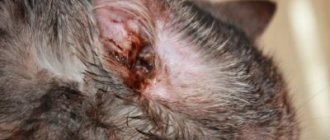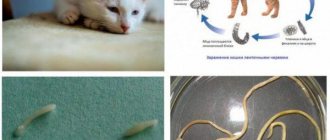If you notice that your cat is scratching its ears and shaking its head more often than usual, then this is a serious cause for concern. Itching in the ears of your ward indicates a disease that can cause deafness if treatment is not started in time. The cause of itching in a cat's ears can be infectious, fungal, allergic and parasitic diseases.
Common symptoms of ear diseases
Regardless of the etiology of the disease, there are general signs that your cat needs medical attention:
- the animal tilts its head towards God;
- the cat presses the sore ear and rubs it with its paw;
- the tailed pet does not allow the owner to examine the ears;
- the cat became irritable, sometimes aggressive;
- in some cases, the patient loses her appetite;
- serous deposits in the ears;
- there is an unpleasant odor coming from the ears;
- redness of the inside of the ear;
- during the period of exacerbation of the disease - discharge from the ears is observed, a squelching sound is heard when pressing on the ear.
How to treat if a cat scratches his ear until it bleeds
If the cat scratches the ear until it bleeds, then the wound is treated with hydrogen peroxide and sprinkled with crushed Streptocide tablets or lubricated with Panthenol, Trauma-gel or Ranosan ointment. It is not recommended to use iodine, brilliant green and Vishnevsky liniment on the auricle. These products have a strong cauterizing effect and can cause burns.
Otodectosis or ear mites
Otodectes (ear mites) is a common parasitic disease caused by the Otodectes cynotis mite. Mites infect the inner surface of the cat's ear, ear canal, and even the eardrum. In advanced forms of otodectosis, parasites invade the meninges, causing disturbances in the central nervous system.
Symptoms of the disease:
- the cat shakes its head, crusts and dirt fly out of its ears;
- an abundant dark brown or black wax deposit forms in the animal’s ears (this plaque is similar in structure to instant coffee);
- lethargy, increased body temperature in the cat, and bowed head may be observed;
- in advanced stages of the disease, the eardrum bursts, and the cat develops neuralgic disorders (fits, convulsions).
Otodectosis has pronounced symptoms, but the final diagnosis can be made by a veterinarian after testing for the presence of ear mites.
Treatment for ear mites in cats
Otodectosis therapy consists of three main measures:
- mechanical cleaning of the ears;
- use of acaricidal drugs;
- strengthening the cat's immunity.
The purpose of mechanical ear cleaning is to remove mites, their eggs and waste products, remove crusts and wax deposits from the ear canal. For this procedure, you need to use disinfectant solutions - furatsilin solution or 3% hydrogen peroxide. To more effectively clean the ear from parasites, it is recommended to use an acaricidal drug, acaromectin, in combination with disinfectants.
After cleaning the cat’s ears from mites and dirt, the ear canal is treated with acaricidal drugs - acaromectin, otoferanol or stronghode. To distribute the medication evenly, gently massage the cat's ears.
To strengthen the cat’s immunity, immunomodulators and vitamin therapy are used:
- ribotan;
- immunofan;
- gamavit;
- mineral and vitamin complexes.
When treating ear mites in a cat, it is necessary to carry out a complete disinfection of the house:
- wash and treat the animal’s bed, rugs and toys with disinfectants;
- Do wet cleaning with disinfectant solutions every day.
If you have several pets, then they also need to be shown to a veterinarian and prevent the disease. After the cat is treated for otodectosis, the veterinarian conducts a repeat test for the presence of parasites. Only if the test result is negative, the cat is considered healthy.
Prevention of otodectosis
Any disease is easier to prevent than to treat. Ear mites in cats are no exception. To prevent otodectosis it is necessary:
- regularly inspect the animal’s ears and clean them if necessary;
- treat the cat with antiparasitic agents in a timely manner;
- observe the rules of hygiene and cleaning of premises;
- Provide the cat with proper nutrition and proper care.
If you find one of the symptoms of otodectosis in your ward, immediately contact your veterinarian to diagnose the disease and prescribe treatment.
Treatment
Of course, if your four-legged friend becomes infected, you should seek help from a specialist. But how can you fight diseases on your own after being diagnosed by a veterinarian?
At home
For each disease, the veterinarian prescribes separate drops, antiseptics or antibiotics, depending on the source of infection and the characteristics of the cat’s body. When choosing treatment at home, you must strictly follow the prescription and prescribed recommendations.
Use prescribed medications to treat wounds, ears and strengthen the animal’s immunity. Monitor his well-being, take care of a comfortable environment.
In the clinic
In advanced cases, the pet needs to stay in the clinic. With the help of surgery, hematomas and abscesses can be removed. After surgery, the animal may remain in the hospital. This is necessary to monitor his well-being and health in order to prevent complications.
Your veterinarian can treat your pet's infection and help remove parasites.
Ear check
Hematoma of the auricle
A hematoma is an accumulation of blood under the skin of the ear at the site of a bruise, cut or bite.
Symptoms:
- the cat's ear swells;
- the damaged ear is hot to the touch, hard and sometimes hangs close to the head;
- a red or bluish swelling is visible on the inside of the ear;
- in chronic cases, curvature of the auricle develops;
- in severe cases, tissue necrosis or an abscess forms at the site of the hematoma.
Treatment of hematoma
If you find an ear hematoma in your cat, immediately apply a cold compress and a tight bandage to the injury site for a day. Don't delay visiting the veterinarian. The doctor should examine the sore ear and prescribe appropriate treatment.
If the cat has a mild hematoma, then it is enough to apply a tight bandage with a cold compress for 2 weeks. After this time, the hematoma will significantly decrease in size and the veterinarian will prescribe UHF therapy.
In case of severe hematoma in a cat, the doctor will puncture the source of inflammation and use a syringe to suck out the accumulated fluid. After this, a 0.5% solution of novocaine with an antibiotic and hydrocartisone will be injected into the hematoma cavity. For effective healing of the hematoma, the veterinarian may prescribe intramuscular injections of Vikasol.
For the treatment of extensive hematoma or advanced form, surgery is indicated.
The only preventative measure against a hematoma in a cat is to ensure that your ward does not get injured and avoid clashes with other animals.
Information for dog owners
Otodectosis in dogs is extremely rare. Treatment of otodectosis in dogs is no different from that described for cats, using drugs as “Bars Forte ear drops for dogs” and “Aurizon” ear drops for dogs. We discussed the first drops in detail earlier. instructions, as well as the price of Aurizon ear drops, on specialized websites. With timely detection and treatment of otodectosis, the prognosis is favorable.
And in order for your pet to always be healthy and not suffer from ear diseases, do not forget about the basic preventive measures:
- ear hygiene,
- regular treatment of your pet with antiparasitic drugs,
- balanced nutrition and preventive examination.
Ear abscess
An abscess on a cat's ear appears as a result of trauma, injury, cut or scratch. Externally, an abscess looks like a hematoma, with only one difference - the abscess is filled with pus, not blood.
Symptoms:
- inflamed area of inflammation that is hot and soft to the touch;
- discharge and unpleasant odor from the ear;
- there may be a scab or puncture wound in the area of the tumor;
- Your cat may show symptoms of a fever, including lethargy and lack of appetite.
Treatment of ear abscess
If you notice an abscess in your cat's ear, contact your veterinarian immediately. At the first stage of the disease, he will prescribe a penicillin-novocaine blockade in combination with warm compresses from sulfonamide drugs.
At the second stage of the abscess, the veterinarian will open the inflammation and remove the pus. Then he will treat the wound with antiseptic drugs and prescribe a course of penicillin or cephalosporin antibiotics.
Why does he shake his head?
Sometimes a cat shakes its head to get rid of accumulated wax or water that has gotten into its ears. Such cases are normal, but should be in moderation. When a pet often tilts its head to the side and shakes it, then there is already cause for concern.
Ear mite
Parasites are a common cause of ear scabies. The cat's ear is designed in such a way that, thanks to certain glands, it is capable of self-cleaning. On the other hand, such an environment is favorable for the development of the parasite. Otodectos cynotis is a mite that causes ear scabies in cats and even dogs. A pet becomes infected with this parasite from an already sick animal. The organ becomes inflamed, our four-legged animal begins to scratch it with its paw, sometimes even releasing its claws, injuring itself. In advanced cases, there is a threat of purulent otitis media.
Ear mite
Ear abscess
Abscess is a purulent disease characterized by rapid development. An abscess develops from scratches and wounds that are not properly treated. Symptoms are: swelling of the wound site, redness of the skin, baldness of the infection site, discharge of pus. If the disorder is left to chance, this will lead to its further development, and healthy tissues will begin to suffer. The best solution would be to contact a veterinarian.
Hematoma
Unlike an abscess, a hematoma is characterized by an accumulation of blood rather than pus. Blood accumulates at the site of the bite or scratch. Small hematomas disappear on their own; treatment of larger ones requires the help of a specialist. A tumor can be identified by an elevated temperature; the wound site usually swells. Usually develops from the inside.
Infectious bacteria
Infectious bacteria can also cause ear diseases. A pet's dirty ears become an excellent breeding ground for microorganisms.
Small pests
Yeast fungus
Bacteria thrive in a humid environment. Owners often assess this disease as simple, the consequences of ear mite removal or otitis, and do not pay attention to the pet’s behavior. The reasons for this enemy are excessive bathing of the pet and high humidity in the room. The manifestation of the fungus is itching, unpleasant odor, and peeling of the skin.
Otitis
When an infection occurs, cats begin to develop otitis media. There are three types of ear inflammation: external, middle, internal. It depends on where the source of the disease is located. The disease is accompanied by fever, lethargy of the pet and loss of appetite. This is one of the most dangerous diseases, which can lead to further hearing loss or complete hearing loss.
You should not treat inflammation yourself without the supervision of a veterinarian.
Dermatitis or eczema
To identify this problem, it is necessary to conduct a full examination of the cat by a veterinarian. Dermatitis can be divided into different subtypes and is a disease of the outer layers of the skin.
Various factors cause the development of infection:
- allergy,
- injury,
- pathogenic bacteria,
- chemical exposure.
Signs of the development of dermatitis include a small red rash, severe scratching of the ear, and clearly visible reddened areas under the fur. Eczema is a type of dermatitis that is rarely an independent disease. It accompanies some pathologies, such as allergies.
Dermatitis in a cat
Erosion and ulcers of the ear in a cat
Erosion and ulcers in a cat’s ears are a manifestation of diseases of various etiologies. To diagnose and identify the causes of ulcers or erosion in the animal’s ears, it is necessary to conduct a comprehensive examination by a veterinarian. The doctor will conduct a cytological examination, hematological and biochemical tests.
Dermatitis
If the cause of erosive-ulcerative dermatitis in a cat is associated with malfunctions in the immune system, then at the initial stage the veterinarian will prescribe the use of mechanical means of protection to prevent self-injury. For example, an Elizabethan collar, overalls or anti-scratch boots.
For the treatment of immune diseases the following is used:
- corticosteroids;
- immunosuppressants.
Bacterial infections
Quite rarely, bacterial infections become the cause of ulcers and erosion in a cat’s ears. Treatment in this case consists of eliminating the cause and antimicrobial therapy. Effective methods of therapy can only be prescribed by a veterinarian after examination.
Neoplasms
It is extremely rare that papilloma, sarcoma or fibroma cause itching in a cat's ear. As these tumors grow, they lead to partial or complete hearing loss. To eliminate the tumor, the veterinarian performs surgery. In most cases, the prognosis is positive.
What is not allowed during processing is prohibited
The ears of adults and kittens are sensitive and need careful attention. Doctors do not recommend when cleaning:
- use soap, iodine, vinegar, alcohol lotions, hydrogen peroxide. These drugs can cause irritation and dryness;
- use cotton swabs, wrap cotton wool around matches. This can damage the eardrum or push debris into the ear canal instead of out.
Lumps or discharge in the ears are a signal to consult with veterinarians at veterinary clinics.
Otitis
Otitis media in cats is a fairly common disease. Most cat owners consider it a harmless disease, but this is a dangerous misconception. If you do not contact a veterinarian in time, your cat may lose hearing or die from complications.
Causes of otitis media:
- ear mite;
- foreign body in the ear canal;
- hypothermia;
- water getting into the ear;
- old sulfur plug;
- injury;
- infectious diseases.
To treat otitis media, you need to contact a veterinarian. As a rule, topical drugs are used to treat the disease in combination with antibiotics and vitamin therapy.
Prevention
- Keep your pet's ears clean and take care of them. Clean them once a week.
- Monitor your pet's walks. Limit contact with sick and homeless animals.
- Inspect your furry's body yourself for scratches and wounds and treat them as necessary.
- Keep your home clean. Parasites such as ear mites can live right in your home due to poor hygiene.
- Boost your cat's immunity. To do this, you need to control your pet’s diet. With a good immune system, the body itself will be able to fight certain diseases.
Keep an eye on your pet. Please note that you should not skimp on your pet’s health, because he is a full-fledged member of the family. We must be responsible for those we have tamed. It is very important to be able to understand your pet, and then you will intuitively feel his health problems. All the best!
Video from the clinic What to do if your cat scratches its ears
How to clean a kitten's ears
Kittens' ears require inspection and cleaning no less than those of adults. At the same time, the kitten behaves unpredictably and experiences stress.
How to care? The baby must be restrained before the procedure to avoid injury (usually, the kitten is not allowed to have its ears cleaned). An active kitten can be swaddled so that only the head is exposed. Do not tighten your pet's paws to avoid further scaring. After the procedure, give the kitten a treat to compensate for the stress caused. If you clean your kitten regularly, it will get used to it and become calmer. To clean, you will need cotton pads and cleansing lotion or boiled water.
- Gently open the ear with your thumb and forefinger.
- Wet the disc with cleaning fluid.
- Wipe the ear from the inside to the exit.
Features of facial skin infections
The blood supply to the organs of the head, face, and membranes of the brain is closely connected. Incorrect treatment and squeezing of pimples is dangerous due to the spread of bacteria through the blood and lymph. You can achieve an increase in the area of the affected area, such dangerous complications as meningitis, abscesses and phlegmon, and inflammation of the eyes.
Before deciding on cosmetic procedures - cleansing, peeling, mesotherapy - undergo an examination by a dermatologist to determine the cause of the pustular rash and receive treatment.
conclusions
When starting to help your pet, you should clearly know what it is sick with. The best help will depend on making an accurate diagnosis.
Help will depend on an accurate diagnosis.
You definitely need to take a close look at the animal and find out all the warning signs accompanying the main symptom.
The doctor will need this information to determine the full clinical picture. Under no circumstances should you try to help an animal yourself if you are not sure of the exact diagnosis.











